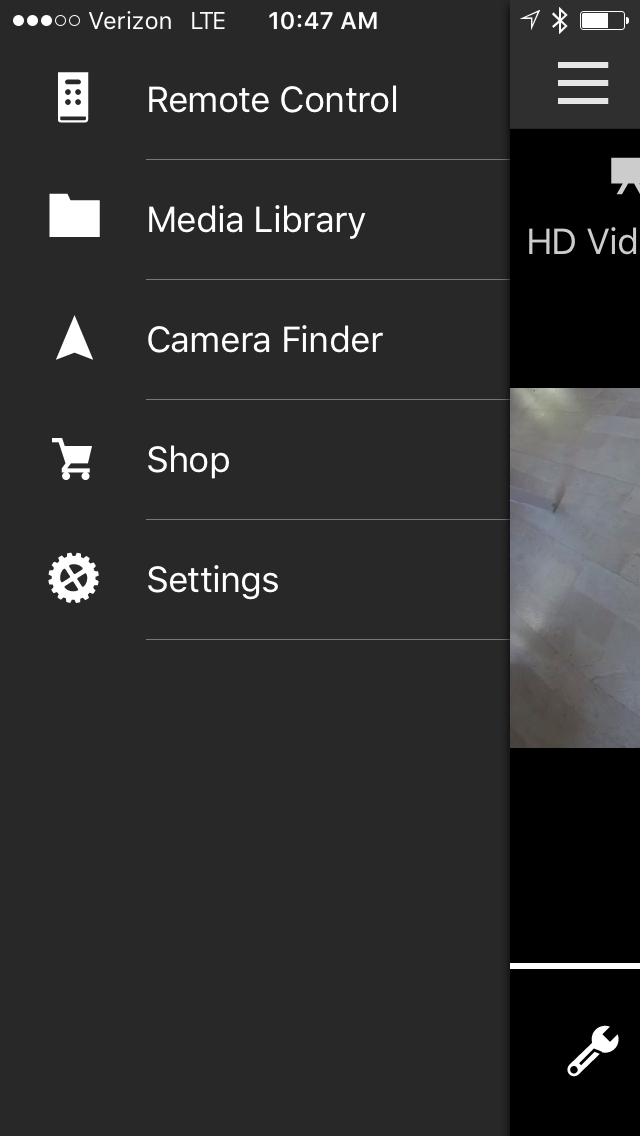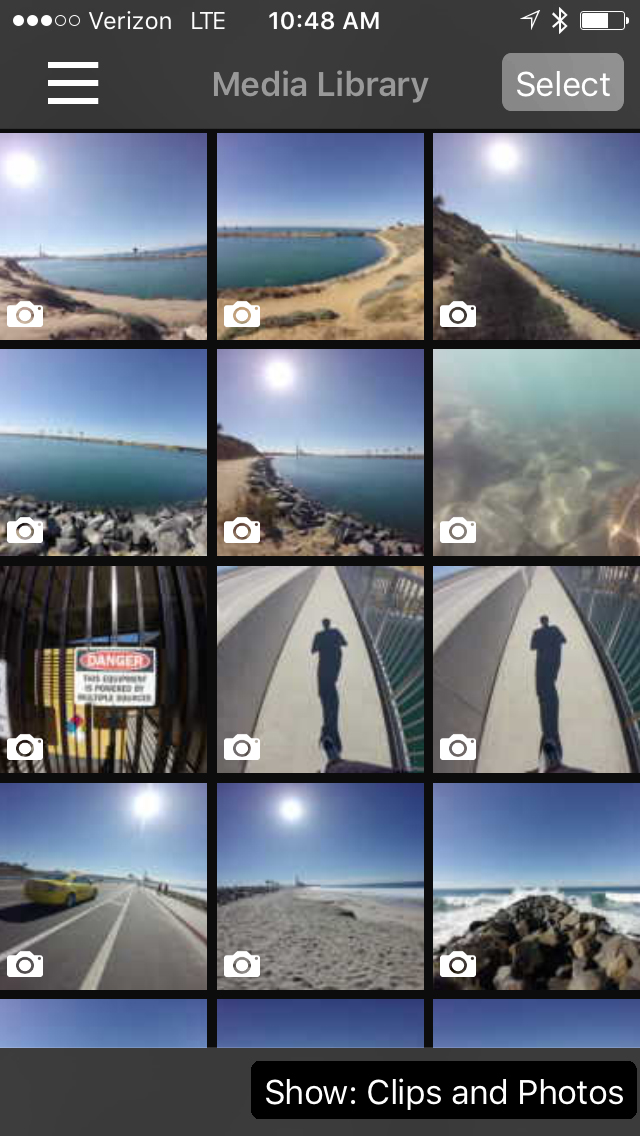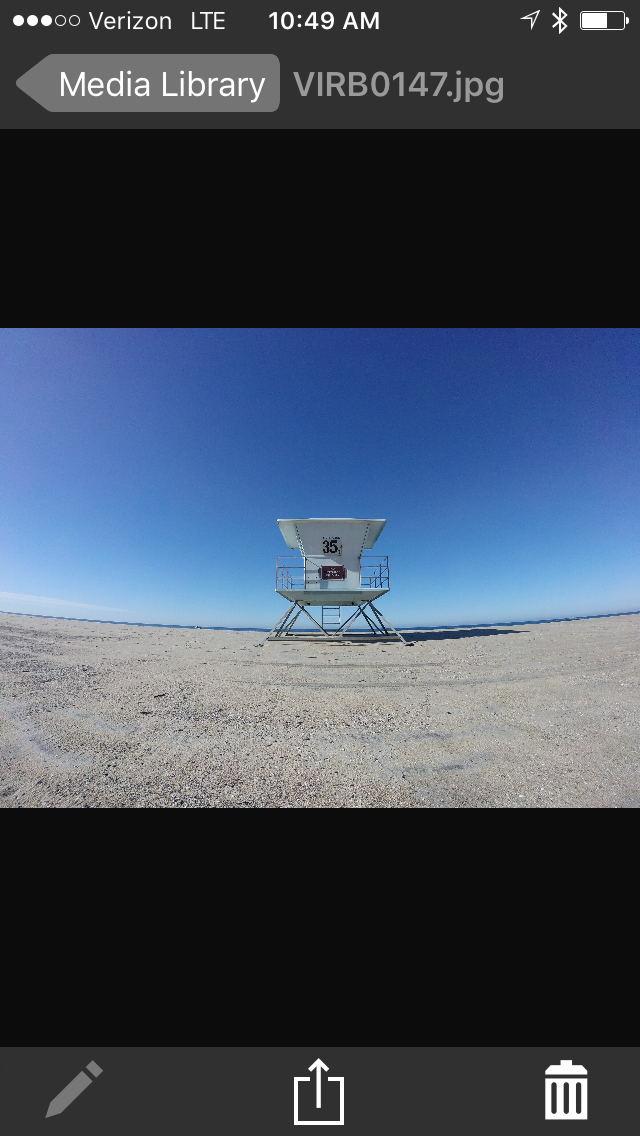- Onboard GPS
- ANT+ sensor compatibility
- Automatic Metric Overlays
- Compatible with all GoPro mounts
- Waterproof
- ANT+ sensors drop occasionally
It’s difficult to discuss action cameras without mentioning GoPro, the company that practically invented the category. Having sold millions, it ignited a new industry that has attracted a lot of “me too” companies, yet, GoPro has continued to dominate. One of the newer entries is the Virb from Garmin, better known for their GPS navigation and fitness devices. During its first year in market Garmin appeared to follow its own path in camera design: The original is lipstick-shaped camera with an LCD screen on the top. While this form-factor worked well for mounting the camera on helmets and handlebars, it wasn’t well suited with chest straps or under bike seats.
Rather than stay different and fight it out, Garmin completely redesigned the new Virb XE with a classic camera shape – a small rectangular box that, not so surprisingly, looks a lot like a GoPro.
That’s only outside of the camera, however. Inside, Garmin did what it know best: it added GPS so the camera knows where it’s going and how fast, and included ANT+ technology so it can communicate with a host of wireless sensors to record performance metrics along with the video. It may look more like a GoPro, but it marches to the beat of its own drum.
Features and design
The Virb XE is a small, compact, matte black box (3 x 1.6 x 1.4 inches) with a lens on the front, and a 1-inch square LCD screen on the top-left with two small buttons to the right (menu and power). On the right side are the shutter button (for still images and menu selections) and a switch to control video recording. On the left-end of the camera is a latch that allows the front of the camera to open revealing the battery and a slot for a MicroSD card. The bottom has a mount that is compatible with most GoPro accessories.
For capturing images the Virb XE has a 12.4-megapixel, 1/2.3-inch CMOS sensor that shoots still photos at 12 and 7 megapixels, and can record video at 1440p up to 30 frames per second, 1080p at 60 fps, 720p at 120 fps, and at 480p in 240-fps super slow motion. In photo burst mode the camera can fire off 12 megapixel images at 30 frames per second. And for getting those classic change-of-weather time lapses the Virb XE can be set to snap at intervals of up to two minutes apart.
For such a small box (it weighs approximately 5 ounces) the Virb XE packs in a load of tech. Along with image capturing, the camera also features GPS, an accelerometer, and the ability to communicate with other cameras, smartphones, and sensors via Wi-Fi, Bluetooth, or ANT+. The onboard GPS means the Virb itself knows how fast it is moving, which direction, the incline, decline, altitude, and how many Gs are being pulled. Garmin calls these features “G-Metrix.” When connected to Garmin’s long list of compatible ANT+ sensors it can track and record heart rate, cycling cadence, temperature, water depth, wind direction and speed, engine RPM, torque, and many other metrics associated with action. These data will automatically appear in a wide variety of data overlays on the video when it is edited in Garmin’s free Virb Edit (for Windows and Mac).
The Virb XE can communicate with the Virb smartphone app via a Wi-Fi connection making the phone both a live viewfinder and remote control. This allows quick photo and video uploads to a smartphone, which can then be shared with any social media app.
What’s included
The Virb XE we tested arrived with the camera, a battery, one USB charging cable, five mounts, two extension arms, three screws for attaching the camera to the mounts, a hex key (Allen wrench), and a get-started manual.
Performance and use
At a certain point all action camera owners realize that they’ll never slip into a wingsuit and base jump off the sheer granite face of a Norwegian fjord. And the chances of them capturing images of mountain bike runs down a rocky Utah cliff are also pretty slim. At that point we all want a camera that just works. And with the Virb XE, Garmin delivers.
It may look more like a GoPro, but it marches to the beat of its own drum.
No offense to GoPro, but one of the features we enjoyed most while testing the Virb XE was that when we pressed the power button the camera turned on. We didn’t have to remove the battery three or four times or do any strange resetting rituals that required plugging the camera into the computer while jumping on one foot.
We also noticed that Virb’s battery would remain charged for longer than a day or two while sitting on our desk. In the past when we’ve wanted to use another action cam for some last minute adventure we’d grab it off the desk only to find that the battery had died in the three days since we’d last charged it. With the Virb we never had that problem. Each time we grabbed it to go, it was ready to shoot. Which is not to say the Virb XE’s battery lasted all day long. With a 16GB MicroSD card in the camera it can hold 1 hour and 18 minutes of video shooting at 1080p at 30 fps, or 3,318 12-megapixel still images. But from our experience that is much more recording than the battery can deliver. With the camera on and shooting clips every now and again we found that the battery lasted on average about 2 hours before going dead – standard for many action cams.
The Virb XE’s interactivity with Garmin’s enormous family of ANT+ sensors is what makes the camera fun to use. On a road cycling ride we paired the camera with our heart rate monitor and cadence sensor and let the camera use its own GPS for speed and direction. Being able to look back at the recording and see our heart rate rise while climbing, or watch how fast we got going on the downhill is cool. And for anyone who races anything, this easy merge of metrics and point of view video is unbeatable. We did have occasional problems with the camera dropping one ANT+ sensor or another, but on the whole it worked as promised.
We also like that the Virb XE has distinct video and photo controls. One toggle switch is for starting and stopping a video recording, while the shutter button is for snapping still images. Once we figured out the position for recording video we were never caught wondering if it was recording or not. While on a mountain bike ride we didn’t have to keep asking the person behind us if the red light was on because we knew the position of the switch. When we wanted to snap a still shot all we had to do was press the shutter button and the shot was taken without disturbing the flow of the video capture.
We all want a camera that just works. And with the Virb XE, Garmin delivers.
As with most action cams, getting used to shooting photos and videos without being able to see what you’re getting takes some getting used to. At the beginning we used the Garmin Virb smartphone app as a display to help frame our images, but soon enough we realized that the camera’s field of view was so wide that it really was as easy as pointing and shooting.
Because the camera is entirely waterproof we didn’t need to put it inside a waterproof box before jumping in a lake or the ocean. And since it’s not in a plastic waterproof box the audio the Virb XE records is quite clear and will be a pleasant surprise to those who are used the the muffled muddy sounds of audio recorded with a GoPro.
Image quality
When it comes to video quality we rolled everything at 1080p at 30 fps. The Virb XE is capable of higher-quality 1080p at 60 fps and 1440p at 30 fps, which you can downscale, but we wanted to work with something more manageable. While the video may not look as hyper crisp or saturated as you’d find on a top of the line GoPro, like the Hero4 Black or Silver, it still records stunning footage that looks great on a computer monitor or posted up on YouTube. Resolution freaks would likely prefer the Hero4 Black’s 4K at 30 frames a second, but for everybody else who don’t enjoy spending all night pushing monster files through a laptop, the Virb EX does the job well even in varying light conditions and underwater.
Virb Edit
What do we do with all this nice HD video, photos, and performance data? Well, Garmin takes care of that with Virb Edit. The software offers everything needed to create a basic, no-frills video edit with metrics overlays. The program facilitates selecting video clips and still photos from the camera and downloading them to the computer. From there, building an edited video is as easy as dragging clips from the media library to a timeline. Virb Edit includes quick editing features like trim to the start and trim to the end, plus several simple transitions including four wipes and a fade. Edit also allows users to import audio to the timeline and control the volume of the clips and audio files. While most of the editing functions are rather spartan, the options list explodes when it comes to data overlays. The app comes with 61 different pre-configured graphic templates and hundreds of solid looks gauges and graphs that can be custom combined to create stunning data data displays anywhere on the screen. Once the overlays are selected, Virb Edit does the rest. The options are virtually unlimited.
After the video is complete, Virb Edit allows for easy exporting to MP4 or can be directly shared to YouTube, Vimeo, Facebook, or Garmin Connect. Serious video editors are going to want more powerful editing software, but for getting a short video edited with full data overlays Virb Edit makes it easy.
Conclusion
The DT Accessory Pack
Up your game and the get the most out of your gear with the following extras, hand-picked by our editors:
Grenade Grip compact hand grip for GoPro HERO cameras ($14)
There’s no good way to hold the Virb XE in your hand, so a grip like this is handy.
GoPole Scenelapse 360-Degree time-lapse device for GoPro HERO cameras ($35)
If you like making motion time-lapse videos, the Scenelapse is a fun accessory.
Garmin chest strap mount for Virb X and XE ($39.36)
A quick and secure way to mount the camera to your body.
K-EDGE GO BIG Pro Saddle rail mount for GoPro Hero ($13.48)
This accessory mounts the camera beneath a bike saddle, so it stays securely out of the way.
We found the Garmin Virb XE to have more functions than that average shooter will use. It does classic time-lapse images, shoots up-close candid stills, and rolls 1080p high-definition video at 60 frames a second. With thoughtful design, intuitive button layout, and easy to understand menus, Garmin has removed most of the overhead normally involved with operating action cams. Video professionals may want some of the custom functionality and higher resolution options found on a GoPro, but for those of us who want to strap on a camera, flip a switch, and record a little video on the fly (with performance metrics included), there is no better action camera on the market.
Highs
- Onboard GPS
- ANT+ sensor compatibility
- Automatic Metric Overlays
- Compatible with all GoPro mounts
- Waterproof
Lows
- ANT+ sensors drop occasionally












